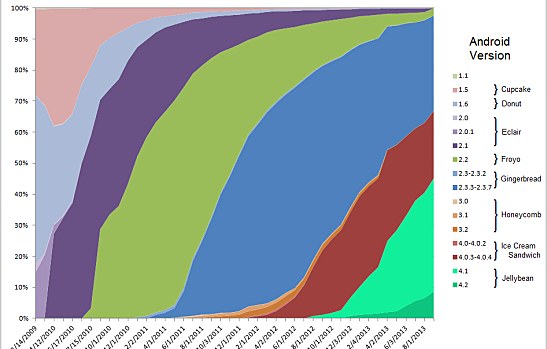Google owns the lion’s share of mobile and smartphone computing software, with 76 percent of mobile devices and 80 percent of smartphones worldwide running some form of the Android OS. This far outpaces Apple, BlackBerry, and Microsoft; Apple in particular owns a large share of the North American market but can’t compete with Android overseas. Unlike Apple, however, Google has always struggled with fragmentation (the use of older versions of its operating system or OS on devices), which has begun to impact adoption as developers move away from Gingerbread to Jelly Bean, with not all users following. A new survey, however, shows that Google is finally taking steps to remedy the problem.
Survey Says…
As reported by Business Insider, Android adoption has stalled at 52 percent in the North American market, despite a record 42 percent of all Android devices finally being updated to some form of Jelly Bean. Meanwhile, Android app developers have managed to reach a point almost on par with Apple developers, earning 90 cents compared to every dollar made by iOS developers. Google’s biggest push, however, is to get all users up to date on Android OS; as a result, Google has decided to directly update Android phones via Google-owned apps and services, in effect making sure all users have the latest and greatest OS version running on their smartphones or tablets. Of course, automatic updates come with a host of complications, not the least of which is that some users prefer the outdated version they’re using, even if a new letter of the Google alphabet might better suit their needs. The search giant needs to be careful here that it doesn’t emulate its closest rival, Apple, which is known for Draconian OS policies — not so much with updates, but with modification and access. Google is better on both counts, but users always want the choice to opt out, especially when a company trots out the “we know best” argument.
Taking Notes
On October 4, 2013, Samsung is releasing the new Galaxy Note 3 running Jelly Bean 4.3, the latest version of the Android OS. The upgrade includes new S Pen features such as Air Command and improved multitasking, and some users are wondering if they should trade in their Note 2 models for the larger display and slimmer design of Samsung’s newest offering. What’s interesting, however, is that Note 2 users can expect in November or December to see 4.3 pushed out to their smartphones, according to Gotta Be Mobile, which will include the same S Pen and Air Command enhancements. In fact, Samsung skipped the Jelly Bean 4.2 upgrade in favor of focusing on 4.3; while Note 2 users won’t get it for a few months after Note 3’s launch, it may make holding on to their current phones cost-effective for the moment.
In the Balance
In this instance, OS fragmentation works in Google’s favor, since skipping 4.2 and giving Note 3 users earlier access to the features of 4.3 may help boost sales. A mandatory push to 4.3 on Android devices would have left Samsung with fewer features with which to draw in consumers at the Note 3 launch, and lower unit numbers moved would mean smaller profit for Google. Ultimately, the search giant needs to find a balance between limiting device fragmentation and encouraging product adoption and upgrading, since both are crucial for mobile users. Perhaps limiting users to the same “family” of OS — Jelly Bean versions, for example — rather than aiming for the highest-numbered release would provide a comfortable middle ground.
The Android OS reigns as king of smartphones and tablets worldwide; Google needs to establish a way to unify the kingdom without aggravating its technology citizens.
Image courtesy of Wikimedia Commons
[cf]skyword_tracking_tag[/cf]

